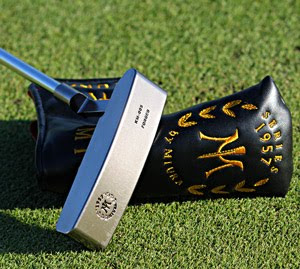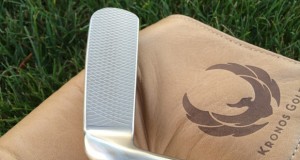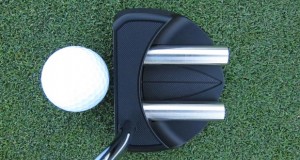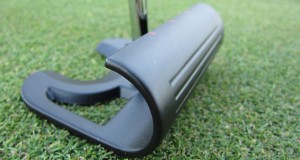From a Japanese city historically renowned for its samurai swords comes another instrument of precision-forged metal—the Series 1957 putter by Miura Golf.
Indeed, in Himeji, Japan, club designer Katsuhiro Miura has built a multigenerational family business around “the pursuit of the perfect set of irons,” a quest that now extends to the putter category as well.
According to Mr. Miura, the limited-edition Series 1957 putters ($399) are “designed for players seeking the very best from a classic design.”
Do the Miura putters live up to their heritage as well as their price tag? Following is PutterZone.com’s Miura Series 1957 KM-005 putter review.
The Storyline
The Miura Series 1957 consists of two models—the KM-350 classic heel-shafted blade, and the KM-005 heel-toe weighted blade with a crank-neck hosel. The KM-005 model features a head weight of 350 grams, and is also available in an alternate configuration of 370 grams called the KM-006.
Katsuhiro Miura has been making forged clubs for more than 50 years, and the name Series 1957 honors the year in which he began his career in the golf business. In his own words, “Japanese philosophical tradition provides that ‘perfection’ is not a goal that can be attained, rather it is a never-ending journey toward a goal. For all my years as a club maker, I have been on this journey and have pursued with a passion the making of the ‘perfect’ forged golf club.”

Miura’s two sons are today actively involved in the Miura Golf operation, with one overseeing the forging division, and the other leading the finishing unit.
The forging process enjoys a long and rich history in Himeji, Japan, where master metal workers have resided for centuries. Today, the fundamental forging process remains the same, even if it is assisted by modern technology. Mild steel is heated, and then struck with a
forging hammer to create the rough shape of the club head. The head is trimmed of excess metal, then struck again for further refinement, and then again a third time. The club is finished by grinding, milling (in the case of the putters) and polishing.
According to the company, “Miura’s forging techniques rearrange the molecular structure of the mild steel in a pattern that is uniform throughout the club head. This eliminates void spots in the club face…This tightness in the grain structure of the metal is what gives Miura-made clubs the controlled, soft feel that other manufacturers cannot achieve.”
Speaking specifically to the Series 1957 putters, the company states: “The Miura forging process creates an ultra smooth surface with very tight dimensional tolerances. The result is a putter with unmatched feel and precision…Each model’s milled face is extremely forgiving resulting in unequaled feel and distance control. The forgiveness at impact also reduces skid, resulting in a truer roll of the ball.”
The stock loft on the Miura Series 1957 KM-005 putter is three degrees and the lie angle is 70 degrees (however, both can be modified at the point of purchase by select dealers). The toe hangs at approximately 4:30. The head material is forged and milled mild steel with a satin “oil chromed” finish.

The View from PutterZone.com
I’ll be honest—I was already in love with this putter before I ever held it in my hands. Why? Because it’s a perfect example of why I started PutterZone.com in the first place: the opportunity to experience and share stories like the one of Katsuhiro Miura.
Even in this modern age, the golf industry manages to produce such stories—stories in which history, heritage, family and craftsmanship flourish amid a hyperactive big-box consumer culture. Such stories are living proof that quality can still trump immediacy.
Personally, I find these stories inspiring, and they are the chief reason why I love putters so much. More than any other club in the bag, putters are the province of the craftsman.
When the Miura Series 1957 KM-005 putter arrived, it met my considerable expectations. This putter is a work of precision and elegance, reflecting the skill and dedication of a master designer.
Visually speaking, the Miura Series 1957 KM-005 putter is a refreshing antidote to the NASCAR-ization of the American putter market, in which no surface seems safe from logos, wordmarks and paintfills. In contrast, Mr. Miura doesn’t see the putter as real estate in need of development, but rather as a natural landscape to be preserved.
Smooth, uninterrupted metal is the dominant visual force on the Miura putter. The shallow sightline along the flange is unpainted, making it more of a suggestion than an actual sightline. The face, topline and bumpers have no markings. The milled pattern on the face is subtle and subdued. Brand ornamentation is limited to an elegant gold “M” in the cavity, a small black Miura logo stamped into the toe end of the sole (and even part of that logo remains artfully unpainted), and the model name “KM-005 Forged” stamped in a small black font on the heel end of the toe. That’s it. The minimalism is verging on cocky, in the best possible sense of the word.
Not surprisingly, the Miura KM-005 putter is a joy to play as well as behold. It sets up beautifully, a picture of quiet symmetry and poise. Some golfers, in fact, might be unnerved by the absence of any visual noise or painted alignment cues. Personally, I appreciate the peacefulness. It clears the mind and enables me to focus solely on squaring the face to the target line, which is the ultimate goal (of course, if your line is wrong, then all bets are off, but that’s not a putter problem). The topline of the putter is fairly thick, which is worth noting because some golfers prefer the look of a thinner topline.
As promised, the feel is phenomenal. It’s plump and juicy, with a nice clicky quality in the back end. The feel is far from hard, but I wouldn’t call it soft, either. The click is also clearly transmitted to the ears for vivid audio feedback. I found the roll off the face to be tight when struck well, and the high-quality feel and feedback contribute to a heightened sense of control.
For maximum putting pleasure with the Miura KM-005, you need to strike the sweet spot just right, as is often the case with high-end milled putters. There are no inserts, grooves or add-ons that might enlarge the sweetness or otherwise mask the inherent properties of the metal. And the inherent properties of the metal dictate that there is a naturally slim sweet spot, and it’s your job to find it. You always know where you stand with a putter like this, and that alone can help you raise your game.
The head weight of 350 grams feels fairly hefty at 35 inches, and I’m sure that the alternate model at 370 grams would be just way too heavy for my tastes. I would actually like to try a lighter option, not a heavier one.
The accompanying Miura head cover is a real beauty, with gold embroidery on black. My only quibble is that the closure is Velcro, which I consider a no-no once you get past the $200 price point. The sound of Velcro from this elegant-looking head cover is like hearing a bad note during a Rachmaninov piano concerto.
I didn’t grasp the “oil chrome” finish until I viewed the putter under a bright sun, which revealed a very subtle rainbow quality at certain angles, which I found to be very cool. The cleanness of the Miura putter is enhanced by the sticker-free stepless Nippon putter shaft and black Lamkin paddle grip, which shows no color markings once your hands are on the club (in contrast to grips that have logos that show beneath the thumbs). This grip is a standard retail version and bears no Miura brand identity, which seems a little odd for a putter of this price. That said, most Miura dealers offer different options for grip and shaft, and so if branding must take a back seat to customization, that’s fine with me.
On that note, let’s talk about the admittedly hefty price of this putter. While the Miura putter excels in matters of feel and performance, I can’t tell you that the Miura putter, at $399, is going to give you 25 percent better performance than a $299 putter like the Cameron California, or 75 percent better performance than a $89 putter like the PING Karsten. If you’re looking at it from that perspective, then this isn’t the putter for you.
But if you view a putter as something more than a blunt instrument, if you can appreciate a putter as a work of art and an heirloom, and if you are willing to pay more for class and craftsmanship as well as quality, then you may want to start saving up for the Miura Series 1957 KM-005.
The Bottom Line
The Miura Series 1957 KM-005 putter ranks among the finest handful of putters to ever pass through PutterZone.com headquarters. It is a work of immense beauty and precision, with performance to match.
 PutterZone – Best Putter Reviews
PutterZone – Best Putter Reviews





Do you know what the relationship between the KM-005 putter and this Mitchell Studio OS Blade Putter is? http://www.mitchellgolf.com/products/Mitchell_OS_Blade_Putter-523-128.html
The designs seem nearly identical.
I don't know if there is a relationship, but you are right, the shaping appears to be very similar.
Have you tried the Yamada putters? If you did, please share the info. And possible if it comparable with the Miura??
Thanks
Alas, I haven't tried Yamada yet, so I don't have a point of comparison.